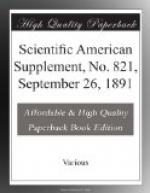The experiments we have made in this direction were conducted as follows. The 300 c.c. bottle containing the gum was placed in a capacious beaker full of hot water, and the viscosity instrument was also surrounded with water at the same temperature. Thermometers were suspended both in the beaker and the outer jar. The viscosity at the highest temperature obtained, about 90 deg. C., was then taken and repeated for every fall of 4 deg. C. till the water reached the temperature of the air.
The values so obtained gradually diminished with the increase of temperature. From the [eta] values obtained the Z values were calculated, using water at 15 deg. C. as a standard. From the Z values thus obtained taken as the ordinate, and the temperature of each experiment as the abscissa, curves were plotted out embodying the results, examples of which are given below. The curves yielded by three gums 2, 7, and 8 changed between 90 deg. C and 100 deg. C., while gum sample 4 has a curve bending between 60 deg. C. and 70 deg. C. Experimentally this increase of viscosity of the latter gum above 60 deg. C. was confirmed, but the critical point of the other solutions tried approaches too nearly to the boiling point of water for experiments to be conducted with accuracy, as the temperature of the bulbs diminishes sensibly while the experiment is being made.
If viscosity values have been determined it is possible to calculate the remaining or intermediate values for Z at any particular temperature from the general equation—
Zt = A + Bt + Ct squared
As an example of the mode of calculation we may quote the following. A gum gave the following values for Z at the temperature stated:
Gum. 50 deg. C. Z_{50 deg.} = 228
Gum. 30 deg. C. Z_{30 deg.} = 339
Gum. 20 deg. C. Z_{20 deg.} = 412
from which the constants—
A = 592.99 B = -10.2153 C = 0.0583
can be obtained, and thus the value of Z_{t deg.} for any required temperature. The numbers calculated for gums all point to a diminution in viscosity up to a certain point, and then a gradual increase. A comparison of some of the figures actually obtained in some of these experiments, compared with the calculated figures for the same temperature, shows their general agreement.
[Illustration: Curves showing viscosity change with temperature for three typical gums. A—Arabic VII. B—Senegal VIII. C—Ghatti 15.]
EFFECT OF TEMPERATURE UPON VISCOSITY—GUM VII.
------------+------+--------+-------------+ Temperature.| [eta]|Z found.|Z calculated.| ------------+------+--------+-------------+ deg.C | | | | 50 |0.0283| 228 | 228.00 | 45 |0.0305| 246 | 246.55 | 42 |0.0352| 284 | 266.75 | 38 |0.0368| 297 | 289.00 | 34 |0.0410| 330 | 313.06 |




